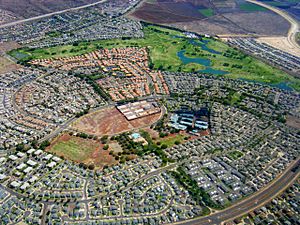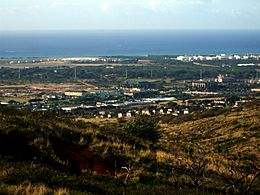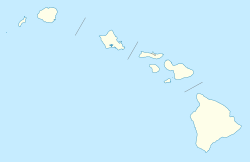Kapolei, Hawaii facts for kids
Quick facts for kids
Kapolei
|
|
|---|---|
| Kapolei | |

Aerial photo of Kapolei neighborhood
|
|
| Nickname(s):
The Second City of Oʻahu, Hawaiʻi's e-City
|
|
| Country | United States |
| State | Hawaiʻi |
| County | Honolulu |
| Government | |
| • Type | Mayor-Council |
| Area | |
| • Total | 4.37 sq mi (11.32 km2) |
| • Land | 4.37 sq mi (11.32 km2) |
| • Water | 0.00 sq mi (0.00 km2) |
| Elevation | 51 ft (16 m) |
| Population
(2020)
|
|
| • Total | 21,411 |
| • Density | 4,900.66/sq mi (1,892.00/km2) |
| Time zone | UTC-10 (Hawaiʻi-Aleutian (HST)) |
| ZIP codes |
96707
|
| Area code(s) | 808 |
| FIPS code | 15-30300 |

Kapolei is a planned community in Honolulu County, Hawaiʻi, United States, on the island of Oʻahu. It is colloquially known as the "second city" of Oʻahu, in relation to Honolulu. For statistical purposes, the United States Census Bureau has defined Kapolei as a census-designated place (CDP) within the consolidated city-county of Honolulu.
The community takes its name from a volcanic cone, Puʻu o Kapolei. In the Hawaiian language, puʻu means "hill" and Kapo lei means "beloved Kapo". According to legend, Kapo, Goddess of Fertility was sister to Pele, Goddess of Fire and Nāmaka, Goddess of the Sea.
Much of the land is part of the estate of industrialist James Campbell. Kapolei's major developer is Kapolei Property Development, a subsidiary of James Campbell Company. Kapolei sits primarily upon former sugarcane and pineapple fields.
Contents
History
In 1955 the Kapolei master plan was drafted and revised 3 different times beginning in 1974. In 1977 the new General Provision Plan adopted the Oahu General Plan which dubbed Kapolei "second urban center" (SUC) on the island of Oahu. In 1986 the Ewa Master Plan was revised to include the SUC and the initial residential construction in the Kapolei area began in the late 1980s with commercial developments springing up shortly thereafter. Nearly two decades later, in 2006 the Kapolei area had more than 800 companies, agencies, and organizations making up approximately 25,000 jobs. As of the 2010 census, the Kapolei CDP had a population of 15,186 people.
The original development objectives for the City of Kapolei were to include: an employment center, a new center for offices and businesses, a center for government offices, a city of people walking, biking, or bussing, the latest energy efficient technologies such as water conservation and recycling, and the most efficient connectivity for commuting on Oahu. In essence a "smart city". The design plan for development ensures that the 7 themes of Kapolei remain the same throughout its construction. These include 1. Hawaiian Garden City 2. Healthy Living 3. Complete Community Services 4. Pedestrian friendly 5. Past/Present/Future design architecture 6. Sustainability 7. Technology.
Kapolei is quickly becoming the second urban center of Oahu, Hawaii's most densely populated island. Much of Oahu's future population growth is projected for the Kapolei area, ʻEwa Plain, and southern slopes of the island's central valley, between Waipahu near Pearl Harbor and Wahiawa near the island's center.
The U.S. postal code for Kapolei is 96707. In 2002, Pacific Business News reported that 96707 had the second highest median income on the island of Oahu, at $62,303. Sperlings's Best Places reports Kapolei median income of $70,129, compared to the national average of $42,350. Nearly one household in five has income exceeding $100,000, with a home ownership rate of 70%.
Communities
Other communities in the Kapolei area are the census-designated places of Makakilo and Naval Air Station Barbers Point (now known as Kalaeloa), the industrial area known as Campbell Industrial Park with its deepwater port, Barbers Point Harbor, and the resort and marina community of Ko Olina, which includes the Disney Aulani Resort and Ko Olina Golf Club.
Transportation
Ongoing road construction has not resolved continuing traffic problems. A Manawai Street-Kama‘aha Avenue extension was completed in August 2006 and helped to reduce congestion along Kamokila Boulevard and Farrington Highway. Kapolei Property Development began construction in January 2007 on a $2 million road to extend Kamokila Boulevard from Kapolei Parkway to Roosevelt Avenue. Kapolei Property Development recently contributed $6 million for a joint project with the State Department of Transportation for an additional freeway on-ramp.
Although state and county governments and some of Hawaiʻi's largest companies have significant workplaces in Kapolei, population growth has far out-paced local job creation. A majority of Kapolei adults work in Honolulu, congesting the main traffic artery, Interstate H-1. In December 2006, the Honolulu City Council approved the Honolulu Rail Transit project, a fixed-guideway elevated rail system connecting Kapolei to Downtown Honolulu. In January 2007, Oʻahu residents saw an increase of 0.5 percent to the general excise tax to help cover the costs of construction of the system. The project broke ground in East Kapolei on February 22, 2011. Work on the foundations for the concrete pillars began shortly after in Waipahu; work to install the pillars started in East Kapolei in April 2012, and the first phase of the project is expected to start service to Aloha Stadium in 2022.
Main roads
Kapolei is located at the southern end of the slopes of the Waiʻanae mountain near the neighborhood of Makakilo with Fort Barrette Road, located along and named for historically important Fort Barrette, connecting Makakilo to Kapolei. It is located on the ʻEwa Plain approximately 25 miles (40 km) from Honolulu. The Interstate H-1 freeway divides more recently developed Kapolei from Makakilo, and traveling eastward on H-1 connects to Waipahu. In the other direction, the freeway ends about 1 mile (1.6 km) west of Kapolei, merging into Farrington Highway (State Route 93) to Kahe and then to Nānākuli on the Wai‘anae Coast. Traveling eastward on Farrington Highway connects to Honouliuli. Exit 1 on H-1 is Kalaeloa Boulevard, the entrance to Barbers Point and Campbell Industrial Park. Less than 1 mile beyond (west of) the merge of H-1 and Farrington Highway is an off-ramp and overcrossing to the West Oʻahu resort area of Ko Olina.
To the south, Renton Road connects Kapolei to Kalaeloa and, further east, to ʻEwa Villages.
Climate
- Highest temperature recorded 96 °F (36 °C) in August 2016
- Lowest temperature recorded 49 °F (9 °C) in March 2005
- Average high temperature in July, 88 °F (31 °C)
- Average low temperature in July, 69 °F (21 °C)
- Average high temperature in December, 80 °F (27 °C)
- Average low temperature in December, 60 °F (16 °C)
- Average rainfall in July, 0 inches (0 mm)
- Average rainfall in December, 3.1 inches (79 mm)
Tourism
- Honolulu High-Capacity Transit Corridor Project, a rail line that is being constructed and will link the Kapolei area to Downtown Honolulu and Honolulu International Airport. When the HART rail project is complete, the western terminus will be located in Kapolei.
Economy
Ka Makana Ali‘i, a mall that opened in October 2016, has 1.4 million square feet of retail space and more than a hundred stores. Macy's Department Store is an anchor for the mall.
Demographics
| Historical population | |||
|---|---|---|---|
| Census | Pop. | %± | |
| 2020 | 21,411 | — | |
|
|
|||
Education
The Hawaiʻi Department of Education operates public schools in Hawaiʻi, including Kapolei. Public elementary schools in the Kapolei CDP include Kapolei Elementary School and Hoʻokele Elementary School, with one public middle school, Kapolei Middle School, and one public high school, Kapolei High School.
Island Pacific Academy (pre-K through 12) in Kapolei CDP, which opened as a private school in 2004, is an International Baccalaureate (IB) school offering IB classes to all grades. American Renaissance Academy (pre-K through 12) opened as a private school in 2007 in Kalaeloa, Naval Air Station Barbers Point.
Barbers Point Elementary School is in Kalaeloa CDP (formerly Barbers Point Housing CDP) but has a Kapolei address. Makakilo Elementary School and Mauka Lani Elementary School are in Makakilo CDP but have Kapolei addresses.
The University of Hawaiʻi–West Oʻahu relocated to Kapolei and opened its new campus in August 2012 at 91-1001 Farrington Highway. Hawaii Tokai International College relocated to Kapolei in April 2015. Wayland Baptist University is also located in Kapolei.
See also
 In Spanish: Kapolei (Hawái) para niños
In Spanish: Kapolei (Hawái) para niños


